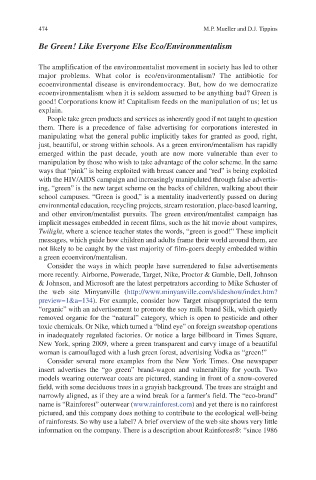Page 499 - Cultural Studies of Science Education
P. 499
474 M.P. Mueller and D.J. Tippins
Be Green! Like Everyone Else Eco/Environmentalism
The amplification of the environmentalist movement in society has led to other
major problems. What color is eco/environmentalism? The antibiotic for
ecoenvironmental disease is environdemocracy. But, how do we democratize
ecoenvironmentalism when it is seldom assumed to be anything bad? Green is
good! Corporations know it! Capitalism feeds on the manipulation of us; let us
explain.
People take green products and services as inherently good if not taught to question
them. There is a precedence of false advertising for corporations interested in
manipulating what the general public implicitly takes for granted as good, right,
just, beautiful, or strong within schools. As a green environ/mentalism has rapidly
emerged within the past decade, youth are now more vulnerable than ever to
manipulation by those who wish to take advantage of the color scheme. In the same
ways that “pink” is being exploited with breast cancer and “red” is being exploited
with the HIV/AIDS campaign and increasingly manipulated through false advertis-
ing, “green” is the new target scheme on the backs of children, walking about their
school campuses. “Green is good,” is a mentality inadvertently passed on during
environmental education, recycling projects, stream restoration, place-based learning,
and other environ/mentalist pursuits. The green environ/mentalist campaign has
implicit messages embedded in recent films, such as the hit movie about vampires,
Twilight, where a science teacher states the words, “green is good!” These implicit
messages, which guide how children and adults frame their world around them, are
not likely to be caught by the vast majority of film-goers deeply embedded within
a green ecoenviron/mentalism.
Consider the ways in which people have surrendered to false advertisements
more recently. Airborne, Powerade, Target, Nike, Proctor & Gamble, Dell, Johnson
& Johnson, and Microsoft are the latest perpetrators according to Mike Schuster of
the web site Minyanville (http://www.minyanville.com/slideshow/index.htm?
preview=1&a=134). For example, consider how Target misappropriated the term
“organic” with an advertisement to promote the soy milk brand Silk, which quietly
removed organic for the “natural” category, which is open to pesticide and other
toxic chemicals. Or Nike, which turned a “blind eye” on foreign sweatshop operations
in inadequately regulated factories. Or notice a large billboard in Times Square,
New York, spring 2009, where a green transparent and curvy image of a beautiful
woman is camouflaged with a lush green forest, advertising Vodka as “green!”
Consider several more examples from the New York Times. One newspaper
insert advertises the “go green” brand-wagon and vulnerability for youth. Two
models wearing outerwear coats are pictured, standing in front of a snow-covered
field, with some deciduous trees in a grayish background. The trees are straight and
narrowly aligned, as if they are a wind break for a farmer’s field. The “eco-brand”
name is “Rainforest” outerwear (www.rainforest.com) and yet there is no rainforest
pictured, and this company does nothing to contribute to the ecological well-being
of rainforests. So why use a label? A brief overview of the web site shows very little
information on the company. There is a description about Rainforest®: “since 1986

